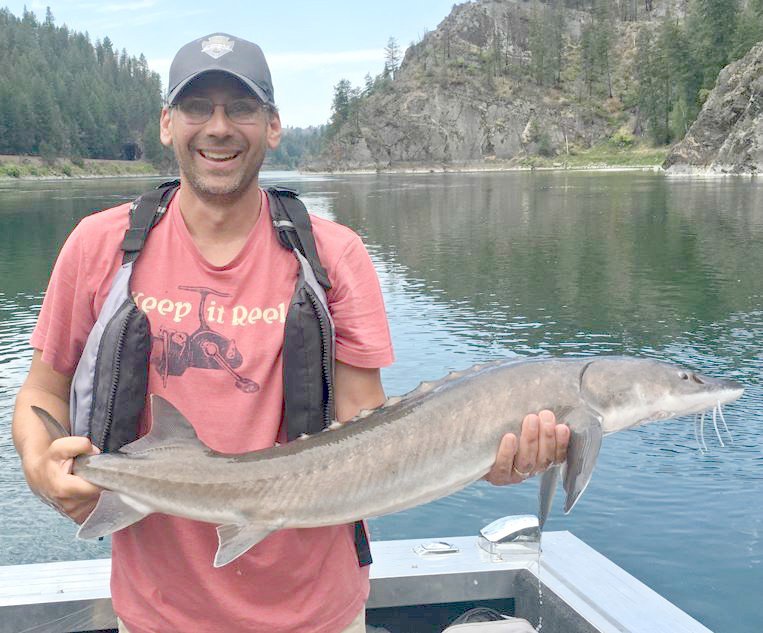Think Long Term With Sturgeon
Declining numbers of juvenile fish may not be a problem for a species that can live 80 years, experts say
- April 12, 2018
- John Harrison

It’s important to take a long-term view of rebuilding fish populations when dealing with a species that can live 80 years or more, a group of sturgeon experts told the Council at its April meeting in Portland.
Long-lived white sturgeon don’t reach spawning maturity until age 15-20 and they may reproduce only every two to 11 years. Data collection for white sturgeon in the Columbia River Basin goes back to the mid-1990s, and while that is a long time it is barely one generation of white sturgeon.
“What we did decades ago is affecting populations today, and what we do today will affect future generations for many years,” said Art Martin, Columbia River Section Manager for the Oregon Department of Fish and Wildlife. Blaine Parker of the Columbia River InterTribal Fish Commission, agreed: “The folks I work with think seven generations down the road. This is not short-term thinking.”
Martin, who spoke about the white sturgeon population downstream of Bonneville Dam, which has access to the estuary, noted that even with that population, the largest in the Columbia River, there are few juvenile fish. “The take-home is that we have a decreasing population of juveniles,” he said, adding that while the lower Columbia population “is not where we’d like to see it, the population is not in danger. These are very long-lived fish; they can handle a few years of decreased recruitment, but not a sustained lack of recruitment.”
Recruitment means the number of fish reaching a life history stage such as larvae to year-old fish, or juveniles to reproductive age. Recruitment also is a problem for white sturgeon populations farther upriver, in the reservoirs behind each dam on the Columbia and Snake river.
In the reservoir between John Day and McNary Dams (Lake Umatilla), for example, the entire population, adults and juveniles, is declining, Parker said. Lack of recruitment has been an issue for many years. Sturgeon densities are an order of magnitude less in Lake Umatilla than in the other reservoirs, and the population is “a strong candidate for supplementation” with hatchery fish, he said.
It’s the same story in the Lower Snake River, Laura Heironimus of the Washington Department of Fish and Wildlife (WDFW) said. Sturgeon in the reservoirs behind Ice Harbor, Lower Monumental, and Little Goose dams have only been assessed twice since the late 1990s, and a comparison shows the population has declined.
“The trend is pretty flat with some small increases probably as the result of high spring flows in some years,” she said. High spring flows are important for sturgeon spawning. “We see older, larger fish in the populations, but overall it’s a pretty random recruitment and a flat population. We’re not seeing the large numbers of juveniles we would like to see.”
There is a bit of good news, however, in the upper Columbia in Lake Roosevelt behind Grand Coulee Dam, where the Spokane and Colville tribes, and WDFW, have been implementing a white sturgeon recovery plan since 2002. The plan includes releasing hatchery-raised juvenile fish into the river – about 150,000 per year -- at multiple locations in Washington and British Columbia, and capturing wild-spawned larvae for the hatchery. The program has been successful – the wild population is estimated at about 2,500 adults, but like other areas of the Columbia, there is a continuing lack of juvenile recruitment in the wild.
However, survival of the hatchery fish is high, especially when the fish are released at age one year. The hope is that continued supplementation will boost wild recruitment over time. Meanwhile, in order to balance hatchery production with genetic management of the species, the state has allowed harvest of hatchery fish – 3,500 were caught in 2017, which coincidentally was 20 years after the fishery was closed because of recruitment failure, Jason McLellan of the Colville Tribes said. “The fishery is incredibly popular,” he added.
Meanwhile, work continues to reestablish and rebuild Kootenai River white sturgeon, an endangered species, through a broad-based program to improve spawning and rearing habitat in the Kootenai River and supplement the population with fish from two hatcheries operated by the Kootenai Tribe of Idaho and the Idaho Department of Fish and Game. Again, as elsewhere, juvenile recruitment of wild fish is a problem, but there also is good news. This spring the tribe caught the first sexually mature male adult sturgeon that had been released into the river with the first group of fish raised at the original hatchery, 26 years ago. It was a moment to celebrate.
“We’re guardedly optimistic because we still have extremely low natural recruitment, but we do recognize the long horizon of sturgeon,” Shawn Young of the Kootenai Tribe said.
Sturgeon Abundance Estimates
Reservoir, Year, Estimate
Lower Columbia, 2017, 635,530 (no reservoir)
Bonneville, 2015, 191,893
The Dalles, 2017, 82,880, (down from 133,259 in 2008)
John Day, 2016, 29,290, (down from 42,622 in 2007)
Ice Harbor, 2014, 2,235 (a decline of more than 50 percent since 1996)
Lower Monumental, 2012, 2,230 in 1997, Insufficient data to estimate in 2012
Little Goose, 2012, 4,180 in 1997; unknown at present
Grand Coulee, 2016, 2,500 wild adults; (3,500 hatchery adults harvested in 2017)
Kootenai River, 2017, 12,000 juveniles, 40 adults taken from the river and spawned each year, no harvest allowed.



